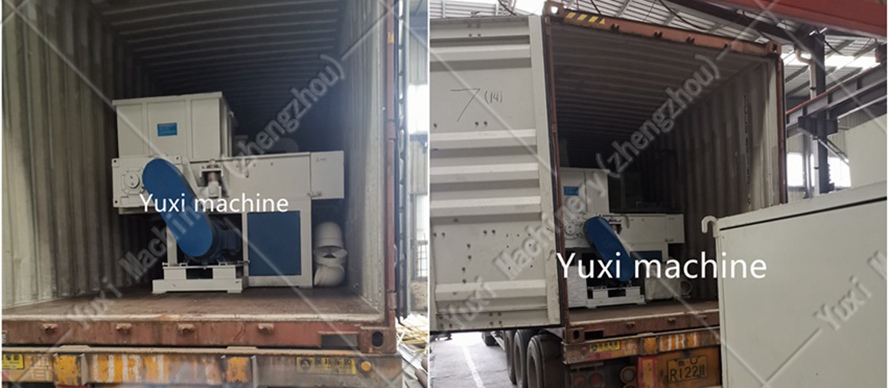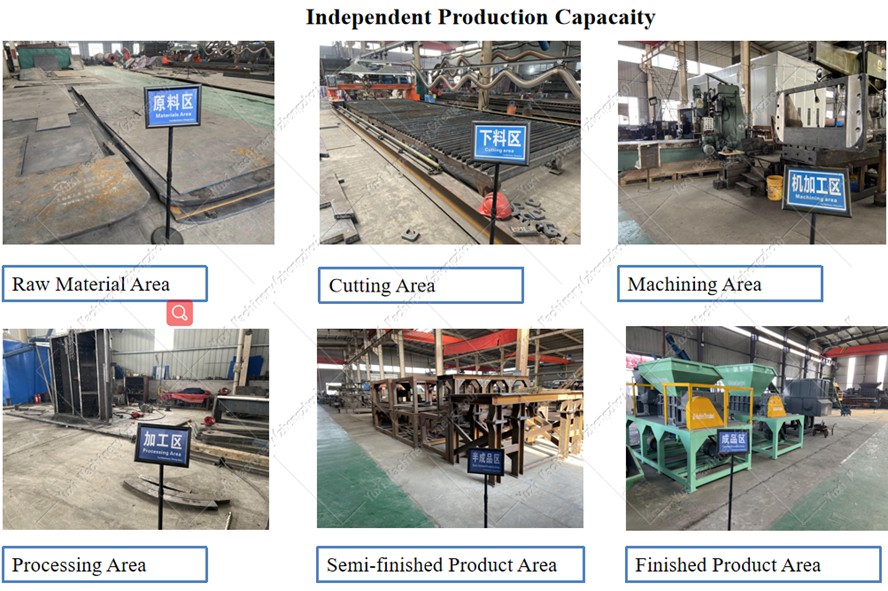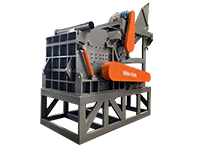In the hundreds of millions of tons of industrial waste generated globally each year, single-shaft shredders play a crucial role. They are not just machines—they are key hubs for resource circulation, transforming what was once "industrial waste" into valuable reusable resources and driving significant progress in environmental protection and resource reuse.
I. Core Equipment: Definition and Technical Composition
A single-shaft shredder is specialized equipment designed for preprocessing industrial waste. It breaks large materials into uniformly sized pieces, creating conditions for subsequent sorting, recycling, and resource utilization. Its core lies in a rotating shaft with interlocking blades that shear and tear materials.
Key Technical Components:
• Rotating Shaft: Equipped with high-strength blades made of ASTM A532 Class III high-hardness alloy, offering excellent wear resistance for prolonged handling of high-strength materials.
• Fixed Knife System: Works with the rotating blades to shear materials, with adjustable angle and gap to suit different materials.
• Drive System: Uses 30–100 HP motors and precision reducers for consistent torque and stability; hydraulic drive systems provide smoother power transmission and overload protection.
• Control System: PLC control with HMI enables automated operation and real-time monitoring, supporting multiple operating modes and parameter adjustments.
• Hydraulic System: Drives the shaft and provides overload protection, with pressure and flow adjustable based on material properties.
• Feeding and Discharging System: Equipped with variable-speed conveyors for uniform feeding and stable discharge.
• Safety Protection System: Multiple safety sensors and emergency stops ensure operator and equipment safety.

II. Working Principle and Process Flow
The workflow of a single-shaft shredder combines mechanical engineering and intelligent control:
1. Material Feeding: Materials are fed into the hopper manually or via conveyor, with speed adjusted based on material properties and load.
2. Shearing and Shredding: Rotating blades interact with fixed knives to shear and tear materials, progressively reducing size.
3. Size Control: Shredded material passes through a perforated screen to control particle size; screens are interchangeable for different sizes.
4. Finished Product Discharge: Material meeting size requirements exits for downstream processing; undersized material recycles for secondary shredding.
This process ensures uniform particle size, ideal for sorting, magnetic separation, and recycling.
III. Real-World Case Study: Scrap Tire Recycling Plant
Client: A leading U.S. scrap tire recycler
Challenge: Inefficient whole-tire processing causing bottlenecks and high costs.
Solution: Deployed a single-shaft shredder with a 50 HP motor and ASTM A532 Class III blades.
Results:
• 30% increase in throughput (from 1.5 to 2 tons/hour).
• 40% longer blade life (from 1,500 to 2,100 hours).
• Consistent 2–3 inch particle size, ideal for magnetic separation and rubber recycling.
• 25% lower operating costs with an 18-month ROI.
IV. Application Scenarios and Processing Objects
(I) Application Scenarios
• Professional Recycling Plants: Core shredding equipment for various industrial waste.
• Resource Recycling Enterprises: Provides uniformly sized feedstock for rubber, plastic, and wood recycling.
• Environmental Treatment Centers: Processes mixed industrial waste for maximum resource recovery.
• Manufacturing: Handles production scrap and rejects for internal resource circulation.
• Municipal Projects: Processes bulky waste and green waste to reduce landfill.
(II) Processing Objects
• Vehicle Parts: Scrap tires, oil filters, engine casings, copper/aluminum parts, steel plates (<10 mm), and forklift pallets.
• Containers: Plastic/metal drums, paint cans, IBC totes, bins, and packaging drums.
• Metal Products: Aluminum, cans, metal drums, aluminum sheets, steel scrap, iron, copper, and other metal waste.
• Waste: Municipal, food, industrial, and green waste.
• Plastics: Pipes, fittings, bottles, frames, blocks, drums, films, and woven bags.
• Wood and Paper: Branches, stumps, construction boards, blocks, newsprint, cardboard, corrugated paper, and copy paper.
• Electronics: Circuit boards, computer casings, CDs, CRT TVs, and washing machines.
• Glass: Glass wool, cups, and fiberglass products.
• Medical Waste: Small devices, clinical/infectious waste, plastics, latex, syringes, and pharmaceuticals.

V. Core Advantages and Industry Value
(I) Core Advantages
• Efficient Shredding: 20–30% more efficient than traditional shredders via shearing/tearing.
• Uniform Particle Size: Screen-controlled output for consistent feedstock.
• Durable: ASTM A532 Class III blades for long life and low maintenance.
• Intelligent Control: PLC automation reduces labor and improves stability.
• Safe and Reliable: Overload protection, temperature monitoring, and emergency stops.
• Flexible: Adjustable speed, rotation, and screen size for diverse materials.
• Environmentally Friendly: Enclosed design and dust collection meet EPA Part 63 and OSHA 29 CFR 1910.1000.
• Cost-Effective: Lower capital and operating costs than dual/triple/quad-shaft shredders.
• Easy Maintenance: Simple blade replacement and adjustable particle size.
(II) Industry Value
• Drives Industrial Upgrading: Transforms recycling from traditional to industrial/intelligent.
• Promotes Resource Circulation: Efficiently recycles rubber, plastic, metal, and wood.
• Supports "Dual Carbon" Goals: Reduces waste pollution and carbon emissions.
• Creates Economic Value: Increases recycled product value and drives upstream/downstream growth.
• Leads Technological Innovation: Advances shredding technology for circular economy.
VI. Technological Trends and Purchasing Recommendations
(I) Future Trends
• Intelligentization: IoT and AI for real-time monitoring, fault prediction, and remote diagnosis.
• High Efficiency: Optimized processes and blades for higher throughput and lower energy use.
• Large-Scale and Modular: Scalable for high-volume needs with modular designs for easy maintenance.
• Green: More eco-friendly materials and processes to reduce lifecycle impact.
• Customization: Tailored solutions for specific client needs.
(II) Purchasing Recommendations
• Processing Scale: Choose models/power based on daily throughput.
• Material Type: Select blade configurations and screens for specific materials.
• Discharge Requirements: Choose screens based on downstream process needs.
• Budget and Maintenance: Balance capital, operating, and maintenance costs.
• Brand and Service: Prioritize proven brands with strong after-sales support.
• Environmental Compliance: Ensure compliance with local regulations/standards.
VII. Frequently Asked Questions
Q1: How long do shredder blades last?
A1: ASTM A532 Class III blades last 2,000–5,000 hours under normal use. Regular inspection, rotation, sharpening, and timely replacement extend life.
Q2: Can single-shaft shredders handle metal?
A2: Yes, but ferrous metals require magnetic separation. Non-ferrous metals may need additional sorting. Control feed rate and material size to avoid overload.
Q3: What is the ideal particle size?
A3: Depends on downstream processes: 2–3 inches for tires, 0.5–1 inch for plastics, and 1–2 inches for wood/biomass.
Q4: How does throughput vary by material?
A4: Depends on density/hardness. A 50 HP unit processes 1–2 tons/hour of tires, 0.5–1 ton/hour of dense plastics, and 2–3 tons/hour of light materials (paper/film).
Q5: How to improve efficiency?
A5:• Regular maintenance and timely part replacement.
• Optimize feed rate and uniformity.
• Adjust speed and screen size for materials.
• Operate within rated load to avoid overload/underload.

Single-shaft shredders are more than equipment—they are vital links in industrial waste to circular economy. With efficient shredding, uniform particle size, and intelligent control, they are reshaping industrial waste recycling. As technology advances, they will play a key role in green development and "dual carbon" goals, driving circular economy.
 Shredding Machine
Shredding Machine
 Waste Recycling Line
Waste Recycling Line
 Optional Equipment
Optional Equipment



